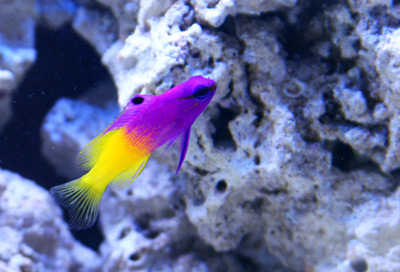I love marine fish. I really do. They’ve been part of my life for decades, and observing their beauty and behavior both in the wild and in aquaria seems to fulfill some primal need in me that’s, frankly, impossible to characterize. But then again, sometimes those scaly little creatures do things that absolutely drive me to distraction. Here are five of them that might sound familiar to my fellow salties:
1. Irritating repetitive behavior
This refers to some type of aggravating perseverative activity exhibited by a fish, such as swimming up and down one corner of the tank or around the same object in the tank over and over again—instead of exploring the entire system available to them. Sometimes you can make sense of this behavior, for example if the specimen is nervous after just being introduced, attempting to evade a bullying tankmate or other stressful stimulus, trying to spar with its own reflection, or, in the case of naturally active species, just burning off energy. But other times, I can discern no particular rhyme or reason to it.
2. The inexplicable startle response
My onespot foxface (Siganus unimaculatus) is guilty of this from time to time. Whenever I approach the tank, the foxface and all its tankmates swim right to the front glass with that eager look that seems to say, “Big Guy’s here! Food’s a-comin’! Get ready!” But then every once in a while, in the midst of the anticipatory celebration, the foxface will suddenly panic, dash at full speed to the farthest corner of the tank, assume a tail-down position, and take on its mottled stress coloration. Moments later, it recovers, resumes its normal coloration, and rejoins the gang at the front glass.
I have no idea what triggers this behavior. Some sound beyond the threshold of human hearing? Shark pheromone spritzed into the tank by another fish as a practical joke? Maybe I have my mouth hanging open on those occasions and the foxface is just thinking, “Uh oh! I’ve seen this guy eat…” Who knows?
3. Sampling the coral smorgasbord
Sometimes fish described as generally reef safe with the possible tendency of nipping at certain coral polyps, e.g., certain tangs, really live up to this profile. That is, they don’t actually eat the corals in a reef tank, but they move from specimen to specimen, giving each a quick little nip—as if they’re thinking, “Now how did this one taste again?” No direct harm is done to the corals, but the repetitive irritation can cause them to remain in a contracted state, depriving their tissues of light, and it can cause real heartburn for the hobbyist.
4. The hunger strike
I always emphasize the importance of verifying that a fish is eating before buying it, but sometimes fish that are feeding in the dealer’s sales tank still go on a hunger strike once they reach their new aquarium. Most assuredly, this behavior is related to the stress of transfer, but it can be extremely frustrating nonetheless to have a fish ignore or spit out every food item offered—possibly including the same food it was happily consuming at the LFS—for days on end.
5. Uncharacteristic hostility
Peace in any fish community is a delicate balance. Sometimes despite our best efforts to choose compatible species and introduce them in the proper order, squabbling is still a problem. This is most frustrating when the combatants in question are species that, based on all the “rules” of compatibility, really should get along.
For instance, CC’s Atlantic blue tang (Acanthurus coeruleus) seems to have it in for his royal gramma (Gramma loreto) and let’s it know by launching attacks whenever the gramma ventures too far out of hiding. Now, A. coeruleus does have something of a reputation for belligerence, but the two are so dissimilar in appearance, food preferences, and the niche they occupy that you’d think they wouldn’t give each other a second thought.
But then fish don’t care how they’re supposed to behave. They just do what they do—and sometimes what they do really drives us nuts!



